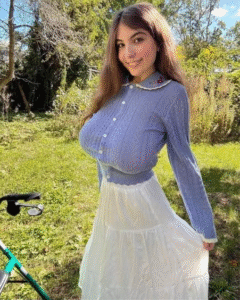The Sundress Moment Everyone’s Sharing
Every year, there’s one unmistakable sign that summer has arrived — not the blooming of flowers or the longer sunsets, but the sight of someone stepping into the golden light wearing a sundress.
It’s that effortless blend of fabric, sunshine, and confidence that seems to capture everything good about warm weather. And lately, the internet has fallen head over heels for what social media is calling “the sundress moment.”
Across TikTok, Instagram, and Pinterest, videos and photos are everywhere: women twirling in soft cotton dresses, laughter caught midair, sunlight glinting through flowy fabric. It’s not just a fashion statement — it’s become a cultural one, a celebration of freedom, femininity, and joy after long months of gray skies and heavy layers.
But what exactly is the “sundress moment,” and why is everyone so captivated by it?
The Origins of a Viral Feeling
It started quietly, as many trends do, with a single phrase. A TikTok video posted earlier this year simply captioned, “It’s sundress season,” showed a woman walking through a park in a flowing yellow dress. The clip went viral overnight — not because of any grand production, but because it captured something universal: the lightness of being that comes with feeling good in your own skin.
Soon, “sundress season” became shorthand for that first real summer day when the air feels alive and clothes feel optional. The hashtag #SundressMoment began trending, collecting millions of views. Some clips are cinematic, filmed in fields or city streets; others are simple — someone dancing barefoot on a porch, dress swaying like a memory.
The appeal is obvious yet profound: the sundress, more than any other garment, has always symbolized ease, confidence, and a return to oneself.
The Emotional Power of a Dress
Fashion historians trace the sundress back to the 1940s and 1950s, when post-war optimism inspired lighter, more joyful clothing. Designers like Claire McCardell and Lilly Pulitzer made the sundress a staple — bright, breathable, and unapologetically feminine.
But beyond its aesthetic, the sundress holds emotional weight. It’s a garment that invites movement. It doesn’t restrict or reshape the body; instead, it flows with it. For many, putting one on feels like exhaling after holding your breath all winter.
“I think it’s less about the dress and more about the energy that comes with it,” says stylist Ava Mendez, who’s worked with several lifestyle influencers. “When you wear something that makes you feel radiant, the world responds to that. The sundress has become a visual language for joy.”
That “joy” — simple, pure, and effortless — is exactly what resonates online. After years of uncertainty and heaviness in the world, people are craving lightness. The sundress moment delivers that, one sunlit photo at a time.
What Makes a Sundress a Sundress
The beauty of this trend lies in its inclusivity. There’s no single “sundress” rulebook — it’s not about brand or body type. Whether it’s a thrifted floral find, a crisp white linen midi, or a bright patterned maxi, the sundress belongs to everyone.
Still, some elements define the classic look:
-
Light fabrics — cotton, linen, chiffon, or rayon that move easily with the breeze.
-
Soft silhouettes — A-line or empire waists, spaghetti straps, or off-the-shoulder styles.
-
Playful patterns — florals, gingham, or soft pastels that mirror summer’s palette.
-
Effortless pairing — sandals, woven bags, loose hair, and minimal jewelry.
It’s fashion stripped of fuss. The goal isn’t perfection; it’s presence — the ability to enjoy the warmth on your skin, the sound of wind through trees, the scent of sunscreen and lemonade.
As one TikTok user captioned her video: “The dress doesn’t make the moment — the moment makes the dress.”
A Symbol of Empowerment and Ease
For some, the sundress moment represents more than seasonal style — it’s an act of self-acceptance.
“I used to hide my body every summer,” wrote one woman in a viral post. “This year, I bought a sundress that makes me feel free instead of small. That’s my sundress moment.”
That honesty is part of what’s made this trend resonate so deeply. It’s not about fitting an aesthetic ideal, but about reclaiming comfort and joy in one’s own body. The sundress is forgiving, but not in the way shapewear or slimming cuts claim to be. It forgives by celebrating, not concealing.
Fashion psychologist Dr. Naomi Ellis explains, “Clothing shapes emotion. When women choose garments that flow rather than constrict, they experience a psychological shift — one toward openness, confidence, and self-connection. The sundress isn’t just an outfit; it’s a reminder to breathe.”
The Role of Nostalgia
There’s also a nostalgic pull to the sundress moment — a return to simplicity in an era of overstimulation. Many describe it as “main character energy,” but in truth, it’s more authentic than cinematic. It’s reminiscent of long summers from childhood: bare feet, melting popsicles, and running through sprinklers in whatever clothes you had on.
That nostalgia isn’t accidental. Social media algorithms favor content that evokes emotion, and the sundress moment taps into that perfectly — a blend of warmth, femininity, and innocence.
Yet beneath the filters and slow-motion spins, the appeal remains deeply human: the desire to feel beautiful without effort.
How Men Joined the Conversation
Interestingly, the sundress moment didn’t stay confined to women. Men began posting videos jokingly celebrating “sundress season” as the time when “everyone falls in love a little faster.” While some posts veer playful or flirtatious, others take a surprisingly wholesome tone — appreciating how confidence and lightness radiate outward.
This crossover only amplified the trend, but it also sparked conversations about respect, gaze, and the meaning behind admiration. The best responses reframed it: the sundress moment isn’t about being looked at — it’s about being seen, fully and freely.
The Fashion Industry Takes Note
Major brands quickly caught on. From Reformation to Zara to smaller indie labels, campaigns began highlighting the “sundress moment” aesthetic — all golden-hour photography, laughter, and linen.
Searches for “sundress” on Google spiked by over 250% compared to last summer, and influencers have declared it the it item of the season. Yet, interestingly, even as it becomes commercialized, the heart of the trend remains refreshingly genuine.
The best sundress moments aren’t in polished ads — they’re in candid clips: someone spinning on a rooftop, walking barefoot through grass, or laughing mid-conversation. The dress just happens to be part of the memory.
A Reminder to Slow Down
Ultimately, the sundress moment isn’t just about fashion or social media. It’s about permission — to feel, to slow down, to exist in sunlight without apology.
It’s a small rebellion against the constant rush of modern life. A sundress doesn’t multitask. It doesn’t hide exhaustion or demand attention. It simply moves with you, asking nothing but that you enjoy the day.
As Mariah Lopez, one of the early creators of the trend, wrote in her caption: “This isn’t about the dress. It’s about the moment you finally feel the sun again.”
The Timelessness of a Simple Joy
Decades from now, the platforms will change, but the essence will remain. Every summer will bring another generation of sundresses — cotton or silk, vintage or new — and another wave of women rediscovering how light they can feel when the world slows down just enough for the breeze to catch their hem.
That’s the beauty of the sundress moment.
It isn’t about trends or validation. It’s about joy.
Simple, radiant, unforgettable joy — the kind that lingers long after the summer ends.


